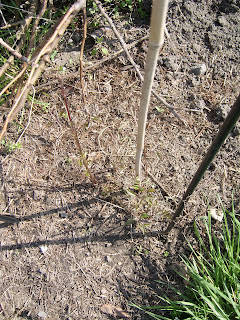Today's allotment battlefield site...

After waxing lyrical last week about the labour-saving benefits of a no-dig system - here I am contradicting myself and engaging in two and a half hours of hard physical work. I've decided I want to re-locate the compost heap. No time like the present.
More than one reason for this. Firstly our allotment-and-a-half is L-shaped. Aesthetically speaking - it would be really nice to visually connect the two parts of it, and most importantly as far as I'm concerned - to be able to gaze at the flowering cherry plums which frame the half-plot in my tea break!
The wooden slot-together compost heap originally stood on the left of the picture - last year this was quite a good place for it as I hadn't cleared the bindweed from the ground on the right of the path. But I really wanted to move the structure to the right as soon as I could.
I've got a rough idea of how much green waste we produce per year and how quickly it rots down. We're going to need some huge empty containers again this year, and we're going to need them at the start of the season. I don't want to be moving compost heap containers whilst I'm trying to sow seeds. So the work I did today really needed to be done now. It has been dry this week (never, ever try turning or moving a compost heap after a rainy spell - it's DISGUSTING work).... the sun was shining a little, I figured if I did the work quickly today the worms wouldn't mind too much and I could tuck them up again before the cold of evening descended.
That was the plan, anyway. I should have learned my lessons by now though I mean NOTHING, BUT NOTHING on the allotment goes exactly to plan...
The wooden compost bin itself was bought the year before last. It set us back around a hundred pounds - about a third of our current allotment budget. Expensive then. I expected it to last more than two years and I expected it to be able to move it.
Somewhere I'd miscalculated. I could take it apart alright, but when I tried to put it back together I discovered that the wood had rotted in a number of places and that some of the screws which held the joints together had fallen out. Maybe I should have taken the time to paint it in eco-friendly wood preservative? Admittedly I could have been more patient with the re-assembly, but it wasn't easy by any means.
Anyway, to be really truthful, I think I would now advise against the purchase of such a system for an allotment holder. Sure it looks fairly neat, but it doesn't seem to last long and if you have even basic joinery skills (I struggle with this one) - you could easily make your own. Lessons learned.
Another fairly expensive purchase last year were the cloches you can see on the right of the picture. Someone once told me you didn't need gimmicks to grow fruit and veg. I understand what they meant now. In theory these cloches are a brilliant idea and they look quite fetching. But in practice they are almost impossible for me to use on the plot. The ends tend to fall off. The biggest difficulty in practical terms is that you need to check them (or lift them to water or ventilate) on a regular basis. If I'm only aiming to visit the plot twice a week I simply can't do this so they are practically useless. Unless I use them without the ends, which I may do occasionally.
Back to the compost heap structure. I feel there is an awful lot to be said for a simple pile, covered up with tarpaulin. Here's the next picture in the series, the composting structure is duly moved to the right hand side of the path:

That's a relief. I seem to have lost some of the slats on the way, though, I suppose they'll turn up sometime...
The good news is, there's lots of almost-ready compost in a huge pile on the left and two more large empty compost bins ready for spring. I'm going to have to put a few nails in this frame now to hold it together as due to the rotting wood it's looking a bit rickety, but I'm sure we'll manage that. We're not the Ideal Homes exhibition, after all.
I've covered the almost-ready compost up with a frost protection sheet. There are so many worms in the pile I need to look after them - so that they'll be fighting fit to start their work as soon as the weather warms up. It's going to be a cold night tonight.
A final picture before I go. This is what I mean about the L-shaped plot. Once I've ditched the cream coloured frost protection sheet and the small trees show their leaves - it will all look much better. Looking forward to those cherry plum flowers this year. Fingers crossed. The plants didn't flower last year. I assume they take a while to get established. Either that or there weren't enough pollinators around last year. The newly-established beehive on our site will no doubt help things along on this front, no doubt.

As for the spot where the compost heap structure used to be - I've created more space now and I'm dreaming of a grape vine...










































